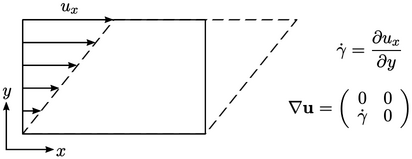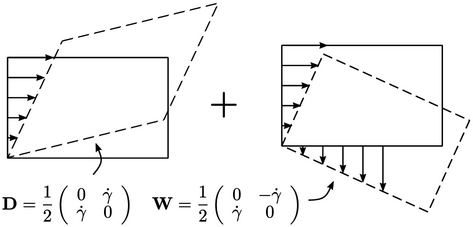2.10 Fluid deformation
Conservation of momentum Eq. (2.19
) includes the  term describing the
forces within a fluid. At a macroscopic level, the forces exist due
to interactions between fluid particles and change due to
deformation of the fluid as it moves.
term describing the
forces within a fluid. At a macroscopic level, the forces exist due
to interactions between fluid particles and change due to
deformation of the fluid as it moves.
From the velocity field  , we need to isolate
pure deformation of the fluid from other characteristics of the flow.
The figure below shows a rectangular fluid element under shear in the
, we need to isolate
pure deformation of the fluid from other characteristics of the flow.
The figure below shows a rectangular fluid element under shear in the
 -direction due to a uniform velocity gradient in the
-direction due to a uniform velocity gradient in the
 -direction.
-direction.
The velocity gradient  calculates some rate of shear of the rectangular
element. The upper diagram shows shear in one direction, known as
parallel shear.
calculates some rate of shear of the rectangular
element. The upper diagram shows shear in one direction, known as
parallel shear.


Parallel shear can be decomposed into pure
shear (left) and a rotation (right). The rotational component is represented by the
skew part of  , see Eq. (2.25
). Since a rotation does not
involve deformation, it must be removed from any measure of it,
which leaves the symmetric part of the
, see Eq. (2.25
). Since a rotation does not
involve deformation, it must be removed from any measure of it,
which leaves the symmetric part of the  tensor.
tensor.
Therefore, the rate of deformation tensor
 and spin
(rotational) tensor
and spin
(rotational) tensor  are defined as
are defined as
 |
(2.33) |
Trace of a tensor
The trace of a tensor  is the sum of the
diagonal components, producing a scalar
is the sum of the
diagonal components, producing a scalar
 |
(2.34) |
 , we conclude from Eq. (2.13
) that
, we conclude from Eq. (2.13
) that
 |
(2.35) |
Deviatoric and spherical tensors
A tensor can be decomposed into the sum of its deviatoric part and a spherical part as follows:
 |
(2.36) |
 is the identity tensor, see Eq. (2.30
). The deviatoric part subtracts
the mean of the trace from each diagonal component such that the
resulting tensor is “trace-free”, i.e.
is the identity tensor, see Eq. (2.30
). The deviatoric part subtracts
the mean of the trace from each diagonal component such that the
resulting tensor is “trace-free”, i.e.  .
.

